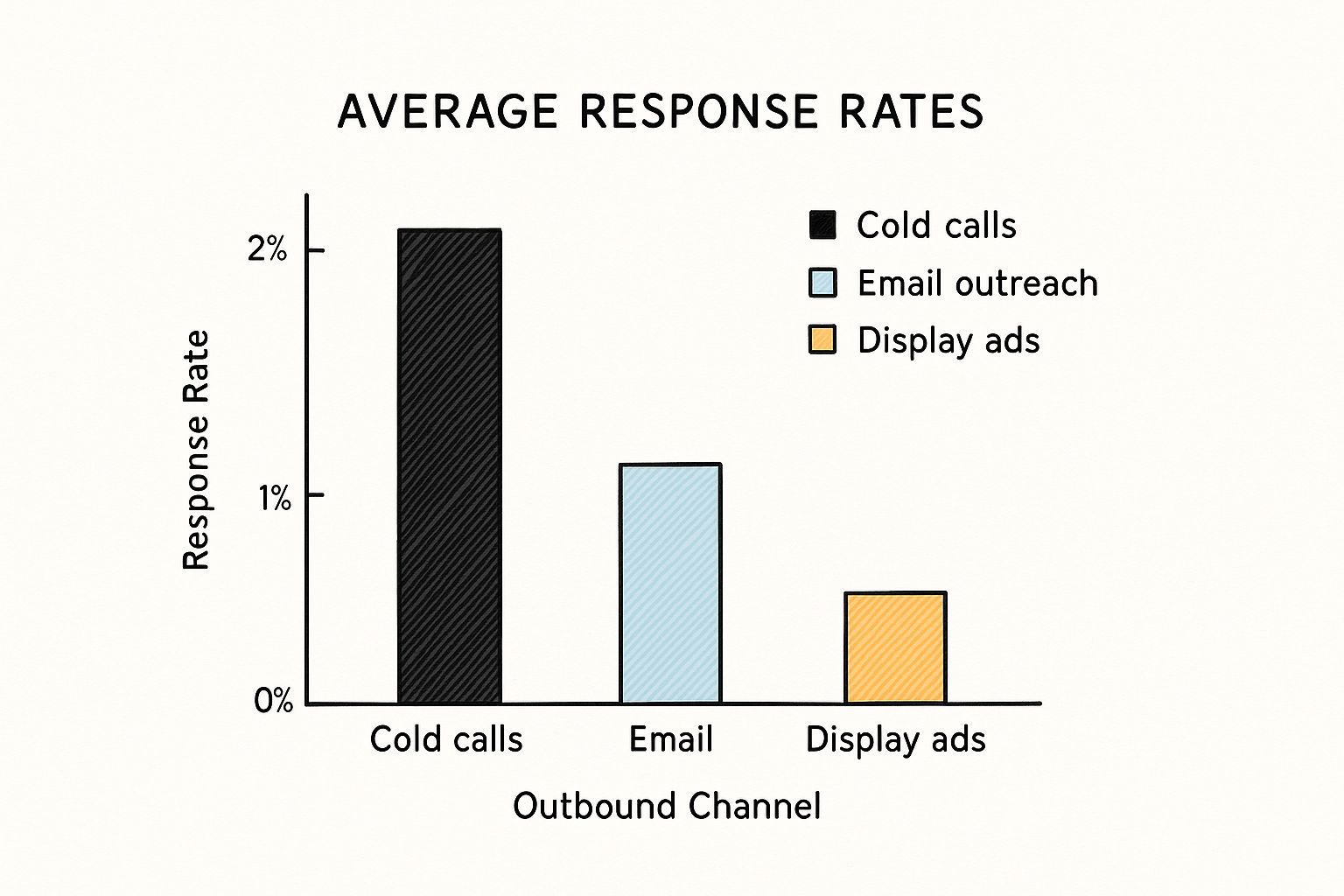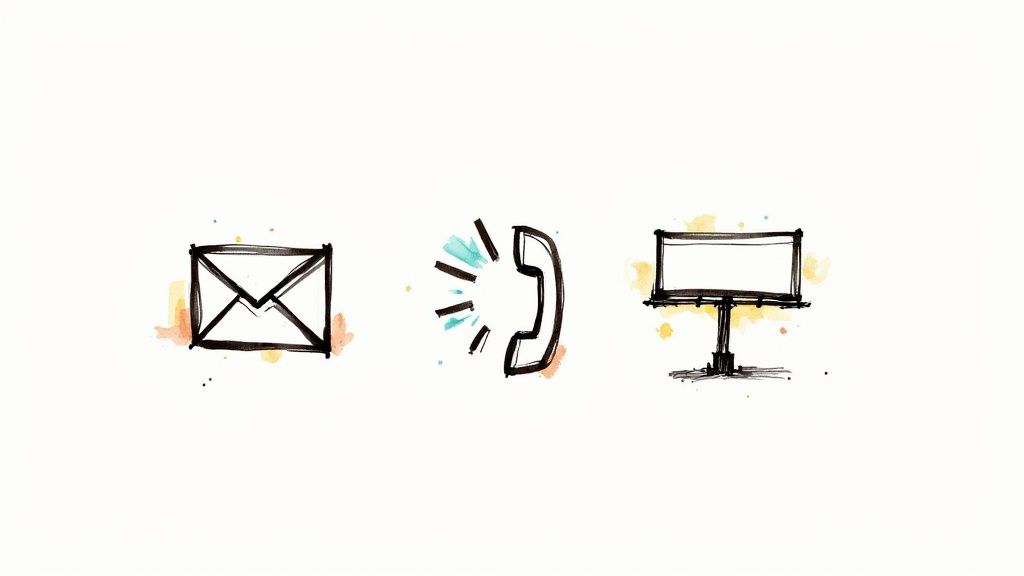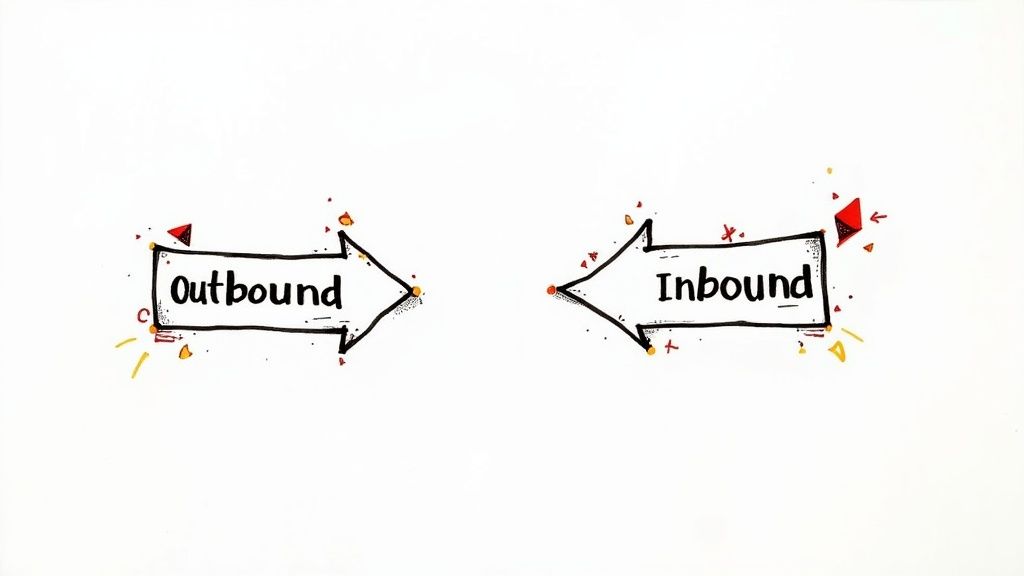What Is Outbound Marketing & How It Works
Outbound marketing is about starting the conversation yourself. Don't wait for customers to find you; go out and get them. Think of it as the difference between being a magnet (inbound) and being a megaphone.
What Is Outbound Marketing Really

Let's cut to the chase. Inbound marketing is like dropping a fishing line and waiting for a bite. Outbound is like using sonar to find a school of fish and casting a net right on top of them. Both work, but outbound is about direct, decisive action.
It’s called "push" marketing for a reason. You're actively pushing your message to a specific audience. It's an assertive, direct approach designed to get your brand on the radar and generate leads fast. You're not waiting for Google to rank your blog; you're buying ad space, sending targeted emails, or picking up the phone to command attention now.
The Core Idea: Initiating Contact
Outbound marketing is about one thing: control. You control who you talk to, when you talk to them, and what you say. This makes it a lethal weapon for startups launching a new product or any business that needs results yesterday.
In short, outbound marketing means using tactics like cold emails, sales calls, and paid ads to actively push your message to a broad audience. The key is to interrupt a potential customer's day in a way that feels relevant and valuable, not just noisy. For a deeper dive, grab these data-driven marketing insights on Databar.ai.
The goal isn't just to be loud; it's to be heard by the right people at the right time. Killer outbound marketing combines a compelling message with laser-sharp targeting to start a real dialogue.
Here’s the no-fluff breakdown of outbound's core DNA.
Outbound Marketing at a Glance
This table gives you a scannable summary of what defines this direct marketing approach.
Characteristic | Description |
|---|---|
Approach | Proactive and direct; you throw the first punch. |
Audience Targeting | Broad reach, but hyper-focused on specific demographics or firmographics. |
Communication Style | One-to-many; a single, powerful message pushed to a large audience. |
Pace | Fast-acting; designed for immediate brand awareness and lead generation. |
Primary Goal | To "push" a marketing message directly in front of potential customers. |
Bottom line: when you need to drive awareness and can't afford to wait, outbound gives you the tools to take control.
Understanding Inbound vs Outbound Marketing
Stop thinking of inbound vs. outbound as a cage match. It's about knowing which tool to pull from your toolbox for the job at hand. Your goals drive the strategy, not the other way around.
Outbound marketing is your go-to for speed and direct market access. Need to generate awareness, book meetings, or drive traffic today? Tactics like paid ads and direct outreach put you in the driver's seat. You're not waiting for customers to find you; you're hunting them down.
In contrast, inbound marketing is about building long-term, sustainable assets. Your blog, SEO, and YouTube channel are patient magnets, attracting customers who are already looking for your solutions. It takes longer to spin up, but inbound creates a durable engine for organic growth that pays dividends for years.
Choosing Your Strategic Approach
So, which one is for you? It depends entirely on what your business needs right now.
A bootstrapped startup trying to land its first ten customers should go all-in on outbound to make it happen fast. An established company might double down on inbound to become the undisputed authority in its niche.
To win, you need to master both playbooks. To get a handle on the other side of the coin, this guide on B2B Inbound Marketing: A Guide to Attracting Customers is your next read. The smartest marketers don't pick one—they blend them.
Key Takeaway: Use outbound for immediate impact and laser-focused reach. Use inbound to build trust, authority, and a lead generation asset that works while you sleep. The real magic happens when you make them work together.
For example, run a highly targeted LinkedIn ad campaign (outbound) that sends traffic to an incredibly valuable, in-depth guide on your website (inbound). This hybrid approach delivers the instant visibility of outbound while capturing leads for your long-term inbound funnel. It's the best of both worlds.
Inbound vs Outbound: A Strategic Showdown
Putting these two approaches side-by-side reveals their different strengths, costs, and timelines. Use this table to decide where your time and money will have the biggest impact.
Metric | Outbound Marketing | Inbound Marketing |
|---|---|---|
Pace | Fast. Generates immediate visibility and leads. | Slow. Takes time to build authority and rank. |
Cost | Higher upfront cost. Requires a direct budget for ads and tools. | Lower direct cost. Requires a significant time investment. |
Targeting | Direct & precise. You pick exactly who sees your message. | Broad & intent-based. You attract anyone searching for your topics. |
Scalability | Predictable scaling. More ad spend equals more reach. | Compounding growth. Efforts build on each other over time. |
ROI | Easier to measure in the short term. Direct link between spend and leads. | Higher long-term ROI. Content becomes a lasting asset. |
As you can see, the choice isn't preference; it's a strategic decision based on your resources and growth targets.
This chart drives the point home by showing average response rates for common outbound channels. It's a stark reminder that precise targeting and a killer message are everything.

The data is clear: even with direct outreach, response rates are often in the low single digits. That’s why successful outbound is a game of both quality and quantity.
Core Outbound Tactics That Still Drive Results

Forget the shiny new objects. A few battle-tested outbound tactics just keep working. This isn’t about shouting into the void. Modern outbound is about precision, personalization, and delivering value from the first touchpoint.
This is your action plan. We’ll break down three core strategies that are crushing it right now, with a mini-guide for each one. The goal: give you practical advice you can use today.
Targeted Cold Outreach
Cold outreach isn't dead—lazy outreach is. Done right, it's one of the most direct ways to spark a conversation with your dream customers. It’s less about volume and more about surgical precision.
This usually happens over email and social platforms like LinkedIn. The secret is making your message feel like a one-to-one chat, not a broadcast. In fact, personalized emails generate a median ROI of 122%. That's proof that a little homework goes a long way.
Pro Tip: Your first email has one job: start a conversation. Don't sell. Ask a smart question or offer a specific insight about their business to spark curiosity.
Here’s a simple, actionable process for cold email:
Build a Hyper-Targeted List: Pinpoint your perfect-fit companies. Then, find the actual decision-makers. Quality beats quantity, every single time.
Craft a Compelling Subject Line: Keep it short, personal, and intriguing. Ditch the clickbait. "Idea for [Their Company Name]" or "Question about your [Specific Project]" cuts through the noise.
Write a Short, Personalized Message: Mention something specific—a recent company win, a blog post they wrote, a shared connection. It proves you’re not a robot. Then, get straight to the point about the problem you solve.
Follow Up Systematically: The money is in the follow-up. Most replies come after a gentle nudge. Send 2-3 polite follow-ups over a couple of weeks. Don’t be annoying; just be persistent.
To nail this, you need the right setup. Check out this guide on the best tools for cold outreach to streamline your workflow.
Strategic Paid Advertising
Paid advertising on platforms like Google Search and LinkedIn is the outbound marketing fast lane. It puts your message directly in front of people who are either actively searching for your solution or fit your ideal customer profile perfectly.
With search ads, you capture intent. Someone Googles a problem, and you're there with the answer. With social ads, you can get hyper-specific, targeting by job title, company size, and industry—a game-changer for B2B.
To get a real edge, dive into detailed guides on effective LinkedIn lead generation strategies to see exactly how to apply these principles.
High-Impact Event Marketing
Whether it's a digital webinar or an old-school trade show, event marketing puts you in a room (real or virtual) full of potential customers. Sponsoring an event, hosting your own, or just showing up at the right conference is a high-impact outbound move.
This is where you build relationships and credibility—fast. Get off the screen and have real conversations. Answer questions on the fly, demo your product, and hear your customers' pain points firsthand. Pro tip: Don't just wait for people to wander to your booth. Book meetings with key attendees before the event starts.
How Technology Is Reinventing Outbound

If you picture outbound marketing as dusty playbooks of cold calls and email blasts, it’s time for an update. Technology hasn't just tweaked the old methods; it has rebuilt the engine from the ground up.
While proactive outreach is still the core idea, the execution is now a precision-guided operation. Modern outbound is smarter, faster, and more personal than ever. It's no longer about casting the widest net. It’s about using data and automation to find the right person with the right message at the exact moment they’re ready to listen.
The Rise of Hyper-Personalization at Scale
The biggest game-changer is AI-powered personalization. In the old days, personalizing outreach to hundreds of prospects was a manual nightmare. Now, modern tools instantly scan a prospect’s LinkedIn activity, company news, and job postings to help you craft a message that feels truly one-to-one.
This isn’t just about [First Name] mail merges. We’re talking about referencing specific projects, mentioning a company milestone, or bringing up a shared interest—all done automatically. This detail transforms a cold interruption into a warm, relevant conversation starter.
The new era of outbound is powered by data-driven relevance. Instead of interrupting a prospect's day, you're showing up with a solution to a problem they're actively trying to solve, precisely when they need it.
This shift completely changes the game.
Automation and Data Enrichment
Another massive leap forward comes from automation and data enrichment. Today’s platforms can automatically find and verify contact information, saving countless hours of grunt work. But it goes deeper than just an email address.
These tools enrich contact profiles with a trove of intel:
Firmographics: Company size, industry, revenue, and their tech stack.
Buying Signals: News of funding rounds, new executive hires, or a spike in hiring.
Engagement Triggers: Real-time alerts when a target account visits your website.
This live data feed lets you trigger automated outreach based on what prospects are actually doing. For instance, the moment a target company hires a new VP of Marketing, a pre-built workflow can send a perfectly timed congratulatory email sequence.
To see how these powerful sequences are built, check out our guide to creating effective marketing automation workflows.
The bottom line? Technology has given outbound marketing a massive upgrade. The brute-force tactics of the past have been replaced with the surgical precision of modern data science, turning it into a formidable growth engine.
Outbound Marketing in Action
Theory is one thing. Seeing how outbound works in the wild is where the lightbulb moments happen.
Let's break down how three different businesses used proactive outreach to get real, measurable results. These aren't just hypotheticals—they're actionable blueprints you can steal for your own growth.
Each example zeroes in on a specific outbound tactic, showing how smart targeting and a clear message turn a cold interruption into a welcome opportunity.
B2B SaaS Lands Enterprise Deals with LinkedIn
A B2B SaaS company selling project management software for construction firms decided not to wait for enterprise clients to find them. They got aggressive with a hyper-targeted LinkedIn campaign.
Their strategy was surgical. First, they built a list of VPs of Operations at the top 100 construction companies. No fluff, just decision-makers. Then, they crafted a short, personalized connection request and a brief sequence of InMail messages.
The magic wasn't in a generic sales pitch. Their first message mentioned a specific, large-scale project the target company had just announced and asked an insightful question about their workflow challenges. This move instantly showed they'd done their homework. By offering value first, they booked demos with over 15% of their target list in the first quarter alone. To see what makes a message cut through the noise, check out these powerful examples of cold emails.
Local Service Business Drives Instant Lead Flow
A local plumbing company needed the phone to ring—fast—for a new emergency repair service. They went for a classic outbound play: geo-targeted Facebook and Instagram ads.
Their approach was brilliantly simple:
Targeting: They drew a virtual 10-mile circle around their office, targeting only local homeowners.
Ad Creative: No fancy video. Just a short clip of a plumber quickly fixing a burst pipe with bold text: "Leaky Pipe? We're On Our Way."
Call to Action: A big, can't-miss "Call Now" button, letting a stressed-out homeowner connect with one click.
Within 48 hours, their phone was ringing off the hook. This is a perfect example of reaching the right audience at the exact moment of need.
Outbound marketing has historically been a powerful driver of brand awareness and immediate lead generation. It casts a wide net to emphasize reach and impressions, which is why campaigns can yield such rapid results. Discover more insights about inbound versus outbound marketing on 310creative.com.
Startup Dominates a Niche with Event Sponsorship
A new fintech startup needed to make a splash in the crowded e-commerce world. Knowing their target audience—online store owners—would all be at a huge industry conference, they invested in a clever sponsorship.
They didn't just get a booth. They sponsored the event's Wi-Fi network.
Every attendee who logged on saw a branded splash page with a killer offer: "Tired of High Payment Processing Fees? Stop by Booth 123 for a Free Rate Analysis." This tactic guaranteed every person in the building saw their brand and message. It drove massive foot traffic to their booth and generated hundreds of qualified leads before the event was over.
Common Questions About Outbound Marketing
Even with a solid plan, you've got questions. Let’s tackle the big ones head-on so you can move forward with confidence.
Is Outbound Marketing More Expensive Than Inbound?
Upfront, yes. Outbound means spending directly on ads, tools, or sponsorships. It's like buying a bus ticket instead of walking; you pay to get there faster.
But the trade-off is speed. Inbound marketing has lower direct costs but demands a massive investment of your time in content and SEO, with a real payoff that can take months or years. The real ROI depends on what you sell. For a high-ticket B2B service, one outbound deal can pay for the entire campaign instantly.
The real question isn't just about cost, but the cost of time. Outbound buys you speed and predictable results, while inbound builds a long-term, compounding asset.
What Are the Biggest Mistakes to Avoid in Outbound?
Knowing the common pitfalls is half the battle. Steer clear of these classic blunders to avoid burning cash and time.
The absolute worst mistake is a total lack of personalization. A generic, spray-and-pray message is the fastest way to get your email trashed. It screams spam and kills any chance of building trust.
Another huge error? Giving up too soon. Good outbound is a sequence, not a one-off email. Most replies come after a few polite, persistent follow-ups. Finally, flying blind by not tracking metrics is a fatal flaw. Without data on open rates, reply rates, and conversions, you have zero chance of improving.
Can Outbound Really Work for a Small Business?
Absolutely. For a small business, the key isn’t scale; it’s surgical precision. You don’t need a giant net when a spear will do the job.
Instead of trying to reach everyone, focus your limited resources on a tiny, hand-picked segment. Here are lean tactics that punch way above their weight:
Manual LinkedIn Outreach: Hand-pick 10-20 ideal prospects. Send a connection request that proves you've actually looked at their profile.
Curated Cold Email Lists: Build a small, high-quality list of dream clients. Craft emails that show you’ve done your homework on their specific challenges.
Geo-Fenced Social Ads: Run small-budget ad campaigns on platforms like Facebook that target potential customers in a very specific geographic area.
For small businesses, winning at outbound is all about focus over volume. Make every single touchpoint count.
Ready to put these strategies into action with the right tools and playbooks? Viral Marketing Lab provides bootstrapped founders with a curated suite of resources—from outreach templates to proven growth blueprints—to help you generate leads and scale your startup without breaking the bank. Start accelerating your growth today.










